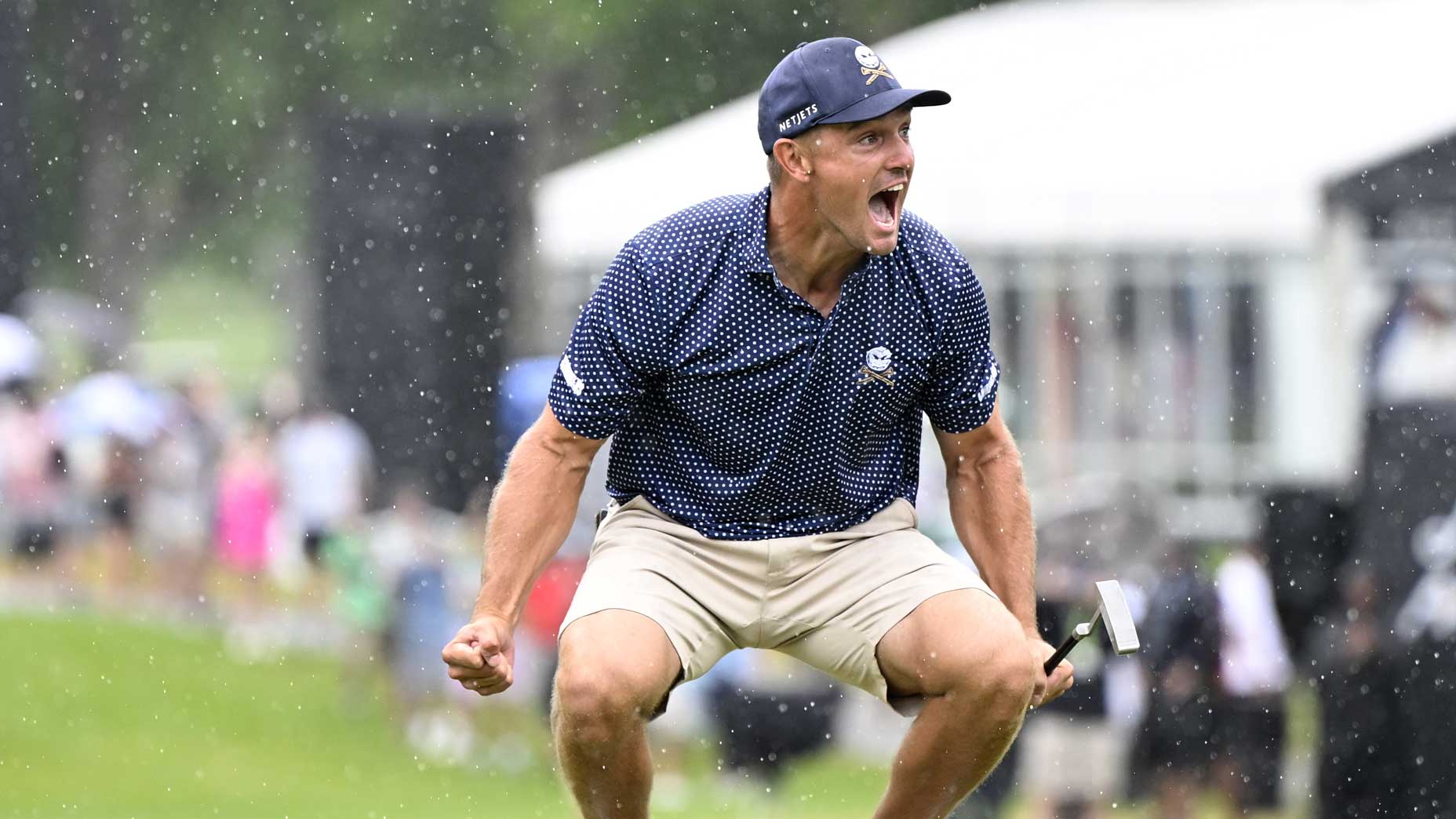
Bryson DeChambeau reacts to his final putt dropping during a Sunday 58 at LIV Golf Greenbrier.
Getty Images
As the Wyndham Championship crept to a close, golf fans weren’t exactly living and dying with the battle that was Lucas Glover vs. Russell Henley. No, they were glued to the action of Justin Thomas, and how the birdies and bogeys he was making — as well as those being made around him — impacted his playoff chances.
It was the rare, riveting storyline playing out well ahead of the leaders. And why was it enthralling? Because Thomas knew what he needed to do. We all did. And he damn near did it. One more birdie or one less bogey to continue making his case for the American Ryder Cup team.
When it was over, the broadcast comfortably pivoted its focus back to the leaders. But the conversation online didn’t seem ready for that move. Why? Because Bryson DeChambeau had shot 58 in the final round of LIV Golf Greenbrier.
For a moment there, it felt ridiculous that two seemingly major golf things could take place at the same time, and neither of them relevant to that week’s PGA Tour winner. But that’s how pro golf has been lately. A bit fractured, with the biggest storylines lurking beneath. Even after Glover’s heart-warming victory, the questions of the week leaned in DeChambeau’s direction.
Just how great was that 58? Wait, has Bryson done enough to merit a captain’s pick?
It was all a reminder of two things: that few pros have a higher ceiling than DeChambeau. Maybe 15, if you had to count. (How many guys can shoot 58…anywhere?) But also that DeChambeau has long been a watercooler topic. You rarely sit on the fence with him.
The pro golf ecosystem is filled with different roles. Glover’s is 20-year Journeyman. DeChambeau’s is Polarizing Performer. He’s not alone (See B. Koepka, P. Reed, S. Garcia — notice the trend?) and he didn’t necessarily choose that role, but he sure has earned it through the years. The analytical way he approaches the game? Perhaps you hate it. The body-morphing he did? Perhaps you’re impressed. The dismissiveness of modern equipment (or of typical equipment!)? Hey big man, prove it to me.
All of it is polarizing. And that’s a good thing. Polarizing puts people in seats. It gets them subscribing to content. A sport where fans are used to only seeing triumph is particularly susceptible to the act of hate-watching. DeChambeau’s final season on the PGA Tour was defined by devotional crowds who traced his every step and the many others who risked being sent home by shouting “Brooksie” at him. It wasn’t surprising that the discourse following his 58 was mostly What an incredible display or its polar opposite: Fifty-eight on a rain-soaked course? Call me when he does it somewhere else. (The correct side of history is that it’s a pretty amazing feat, one of the best in LIV Golf’s young existence, and still not one of the best five rounds of this golfing calendar.) Sports competitions that breed two- and three-day long debates are good for business, and DeChambeau finally delivered that for LIV, a full 13 months since he joined the enterprise.
He conveniently doubled down on public attention after his Greenbrier conquest by uploading a 39-minute video to his YouTube page, titled “I challenged Phil Mickelson to a 9 hole Match”. If that’s the kind of content that intrigues you, click here. The video is good. And it was produced in just four day’s time. For a 39-minute video, that’s quick.
It taps into the ways golfers at home digest this sport digitally, with non-stop action, shot-after-shot-after-shot, shot-tracer, brief moments of levity, a story-arc, etc. It doesn’t hurt when you can inject a Hall of Famer’s name into the YouTube algorithm. But this golf content was also exactly the kind of thing that would have been painstaking to execute if Mickelson and DeChambeau were members of the PGA Tour.
A key facet in pro golf’s civil war can be traced back to media rights and the Tour regulations that protect them. Tour members annually sign away their golfing media rights, which allows the Tour to bundle them together in a roughly $700-million annual package. That means players cannot simply compete in a broadcasted tournament in Australia during the Rocket Mortgage Classic. It’s why, say, GOLF.com couldn’t stream a hit-and-giggle between Jon Rahm and Tommy Fleetwood without a long list of approvals. Tour pros cannot create a made-for-YouTube competition on a whim. But as we’ve seen countless times in the last year, there are fewer traditions at LIV Golf. Their rules are new and flimsy enough to be changed.
The content creation proved rather simple for DeChambeau’s team to execute. Perhaps too simple to be monetarily valuable to the LIV Golf league. But DeChambeau has uploaded exactly 79 videos to his YouTube page over the last two years and this is the only one that has eclipsed one million views. After four days, it has more viewers than any PGA Tour YouTube video posted in 2023.
It was fitting that DeChambeau was joined on camera mostly by Mickelson, who DeChambeau has obediently followed into the rich, uncertain LIV Golf future. When you talk with either of them about the current state of the game, they mention a lot of the same things. As far as watercooler topics go, Mickelson is a Hall of Famer there, too. This week should tell you that. Rory McIlroy is well on his way, and he proved it again Thursday. (Was his quip fair game or ill-spirited?) Brooks Koepka has been proving it all season long. (Does any big event matter if Koepka isn’t playing?) Justin Thomas is a watercooler topic, to an extent. Dustin Johnson a watercooler topic, to an extent. Russell Henley isn’t. Cameron Triangle isn’t. What we’re learning most these days is that some people move the needle and many others don’t. Bryson DeChambeau can move it pretty easily, and there’s a ton of value in that.









